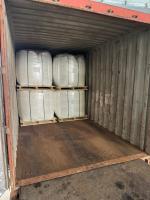anionic flocculant of Nalco 9825 can be replaced by chinafloc A5018
Description of the polymer: Liquid latex type of flocculant; anionic charged with 40% charge density and very high molecular weight above 20 million. The polymer is used in Alumina plant waste water treatment
The use of anionic flocculants in alumina plant wastewater treatment is a significant aspect of modern industrial processes. Alumina production, primarily through the Bayer process, generates a considerable amount of wastewater that contains various organic and inorganic materials. Managing this wastewater efficiently is crucial for environmental protection and sustainable operation of alumina plants. Anionic flocculants play a pivotal role in this context.
Understanding the Bayer Process and Wastewater Generation
The Bayer process, the primary method for extracting alumina from bauxite ore, involves treating bauxite with sodium hydroxide at high temperatures and pressures. This process extracts alumina (aluminum oxide) from bauxite, leaving behind a highly alkaline and caustic waste material known as red mud. Alongside red mud, the process generates a substantial amount of wastewater that contains fine particles, caustic soda, and various other impurities.
Composition and Challenges of Wastewater
The wastewater from alumina plants poses several challenges:
-
High Alkalinity: The presence of residual caustic soda makes the wastewater highly alkaline.
-
Suspended Solids: Fine particles from the processing can remain suspended in the water.
-
Organic and Inorganic Impurities: Various impurities from the bauxite and the process additives are present.
-
Environmental Concerns: Discharging untreated wastewater can have severe environmental impacts.
Role of Anionic Flocculants
Anionic flocculants are essential in treating this wastewater. They are long-chain polymers with negative charges. When added to wastewater, these negatively charged molecules interact with positively charged particles in the water, leading to several beneficial effects:
-
Particle Aggregation: The flocculants cause fine particles to aggregate, forming larger flocs which are easier to separate from the water.
-
Enhanced Sedimentation: The aggregated particles settle more quickly, speeding up the clarification process.
-
Improved Sludge Dewatering: The formation of larger flocs makes it easier to filter and dry the sludge, which is a critical step in waste management.
Application in Alumina Wastewater Treatment
The application of anionic flocculants in alumina plant wastewater treatment involves several stages:
-
Preliminary Treatment: Initial removal of large solids and adjustment of pH levels.
-
Flocculant Dosing: Anionic flocculants are added to the wastewater in controlled doses.
-
Mixing: Efficient mixing ensures optimal interaction between the flocculant and suspended particles.
-
Sedimentation: Aggregated particles settle at the bottom of sedimentation tanks.
-
Filtration and Dewatering: The settled sludge is further processed to remove water and reduce waste volume.
Selection of Anionic Flocculants
Choosing the right anionic flocculant is critical and depends on several factors:
-
Molecular Weight and Structure: Determines the effectiveness in bridging and aggregating particles.
-
Charge Density: Must be suited to the charge characteristics of the wastewater constituents.
-

